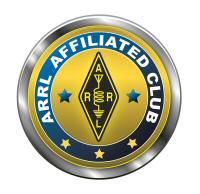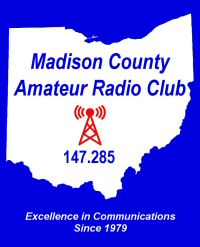The Repeater System is operated by the Madison County Amateur Radio Club,
and is open for all amateurs to use. The Repeater System is located in
central Madison County, Ohio. There are also three remote receiver sites
located in Plain City, West Jefferson, and Mt Sterling at the north, east,
and south ends of the county respectively. This enables low-powered
handheld coverage throughout the entire county, and mobile coverage over
most of the adjoining counties. All sites have emergency backup power.
The repeater is also available via EchoLink® from anywhere in the world at
KE8RV-R (node 989602).
REPEATER NEWS
by Repeater Trustee - Don Kovalchik-W8DPK
In
November 2022 the Plain City remote receive site for the Club's KE8RV
repeater stopped operating. An inspection revealed that it had gotten wet
- the paper labels were destroyed and the two antenna cable connectors were
corroded onto the equipment. The equipment was not in any sort of
enclosure, and was located right next to the rear overhead doors of the
firehouse so I suspect that rain (or other events) got the equipment wet. The receiver, transmitter and power supply were just sitting on a make-shift
table. I removed the equipment and brought it home for repair.
Here's what I found:
- The 12V power supply had an output of 25V - not good for the
equipment!
- The UHF link transmitter survived! No damage despite having 25V
applied.
- The back-up gel-cell battery was fried
- The receiver had 2 blown ICs and a blown RF amp transistor
- The squelch control was very erratic after the receiver was repaired.
The UHF link transmitter is only about 1 Watt, and it is connected to a high
gain directional antenna pointing at London. That was sufficient when the
main repeater was located in London where the directional link receive
antenna was 120-ft high and pointing back at Plain City. Now that the main
repeater is (temporarily) located in West Jefferson, the link signal from
Plain City to West Jeff is very weak and noisy, and is not reliable. To
improve the situation, I increased the link transmitter power from 1 Watt to
over 30 Watts by adding an amplifier to the transmitter. Larry - N8CWU
donated the amplifier that he bought at a hamfest a few years ago. I had
repaired the 12V, 1A power supply that was water damaged, but with the new
amplifier added, the system needs over 10A, so a new power supply was
required. I had a spare 20A power supply to use.
I also had an old steel 19" rack equipment cabinet to use to enclose the
radios to prevent future water damage. It had lots of surface rust so I
sanded and painted it - now looks like new. I added rubber feet and
handles. I mounted the receiver and transmitter to a new 19" rack panel.
The heavy power supply and UHF amplifier is mounted on the bottom.
I tested the equipment here at my QTH for a few weeks to verify its
performance. With heavy use, like during our evening nets when it might get
several hours of continuous use, the power supply and amplifier got VERY
hot. I added fans to the heat sinks to keep things cool.
I also updated the firmware in the controller. The controller has 9
operation modes (various combinations of squelch and CTCSS tone modes,
timers, etc...) that can be remotely programmed by over-the-air DTMF
commands. The old firmware did not remember the current mode settings
during a power failure and always would reset to the default mode when power
returned. The new firmware stores the current mode into non-volatile memory
so the correct mode is restored when power returns.
The equipment was re-installed at the firehouse in mid-December 2022. New
connectors needed to be put on the two coax feedlines. The RG-8 coax to the
UHF link antenna was corroded from water intrusion. Probably the entire
cable is bad. I suspect that water is getting in at the antenna connection
and is wicking down the braid. An SWR sweep of the UHF antenna and coax was
bad - there was no resonance anywhere. The SWR was between 2:1 and 3:1 over
the entire spectrum. That's typical of lossy, water-damaged coax. That
needs to be replaced someday. The other coax (LMR-400) to the 2-meter
antenna looked OK and the SWR sweep was good. Despite the bad UHF coax,
with the extra power from the UHF amplifier the receive site is now working
reasonably well.
Remember, due to frequent local interference, the Plain City receive site is
usually in CTCSS tone protect mode. Use 82.5 Hz CTCSS to activate that
receive site.
An
EchoLink® interface was added in December 2017.
Many new upgrades occurred in 2005 regarding the KE8RV
repeater system. Under the guidance of Repeater Trustee, Don
Kovalchik-W8DPK, the repeater system took a leap into the future.
All three remote receive sites are now sporting a new micrprocessor-based
controller that is optimized for a multi-receiver voted repeater system.
The firmware, written by W8DPK, features several CTCSS and carrier access
modes, multiple timers, and very sensitive DSP CTCSS and DTMF decoders. A single
2.5" x 3.5" PC board replaces the three much larger boards that were
previously used.


WELCOME!
You are encouraged to use the 2-meter system at
147.285+ MHz (82.5 CTCSS)
THE KE8RV
REPEATER TECHNICAL WEBSITE (KE8RV),
takes you to an external website, containing all the technical details of our
repeater system, current repeater status, and plenty of photos.






